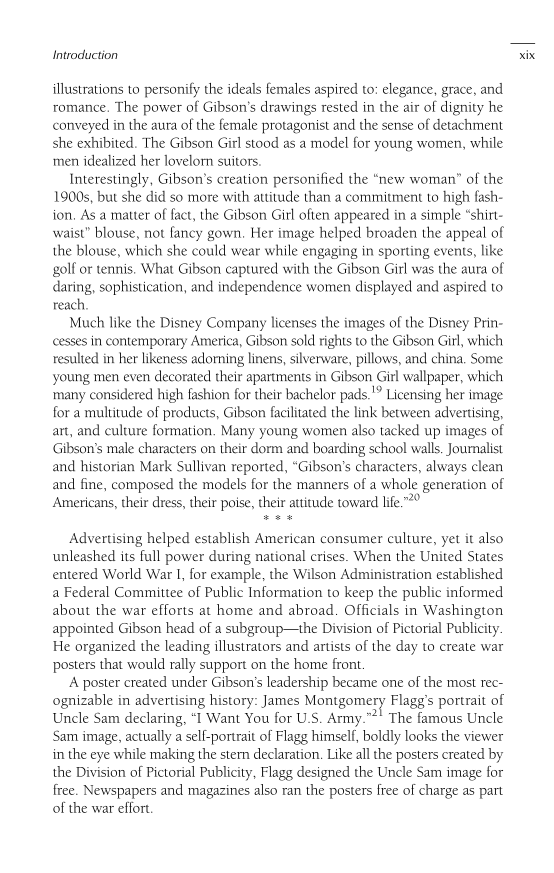illustrations to personify the ideals females aspired to: elegance, grace, and romance. The power of Gibson’s drawings rested in the air of dignity he conveyed in the aura of the female protagonist and the sense of detachment she exhibited. The Gibson Girl stood as a model for young women, while men idealized her lovelorn suitors. Interestingly, Gibson’s creation personified the “new woman” of the 1900s, but she did so more with attitude than a commitment to high fash- ion. As a matter of fact, the Gibson Girl often appeared in a simple “shirt- waist” blouse, not fancy gown. Her image helped broaden the appeal of the blouse, which she could wear while engaging in sporting events, like golf or tennis. What Gibson captured with the Gibson Girl was the aura of daring, sophistication, and independence women displayed and aspired to reach. Much like the Disney Company licenses the images of the Disney Prin- cesses in contemporary America, Gibson sold rights to the Gibson Girl, which resulted in her likeness adorning linens, silverware, pillows, and china. Some young men even decorated their apartments in Gibson Girl wallpaper, which many considered high fashion for their bachelor pads.19 Licensing her image for a multitude of products, Gibson facilitated the link between advertising, art, and culture formation. Many young women also tacked up images of Gibson’s male characters on their dorm and boarding school walls. Journalist and historian Mark Sullivan reported, “Gibson’s characters, always clean and fine, composed the models for the manners of a whole generation of Americans, their dress, their poise, their attitude toward life.”20 * * * Advertising helped establish American consumer culture, yet it also unleashed its full power during national crises. When the United States entered World War I, for example, the Wilson Administration established a Federal Committee of Public Information to keep the public informed about the war efforts at home and abroad. Officials in Washington appointed Gibson head of a subgroup—the Division of Pictorial Publicity. He organized the leading illustrators and artists of the day to create war posters that would rally support on the home front. A poster created under Gibson’s leadership became one of the most rec- ognizable in advertising history: James Montgomery Flagg’s portrait of Uncle Sam declaring, “I Want You for U.S. Army.”21 The famous Uncle Sam image, actually a self-portrait of Flagg himself, boldly looks the viewer in the eye while making the stern declaration. Like all the posters created by the Division of Pictorial Publicity, Flagg designed the Uncle Sam image for free. Newspapers and magazines also ran the posters free of charge as part of the war effort. Introduction xix
Document Details My Account Print multiple pages
Print
You have printed 0 times in the last 24 hours.
Your print count will reset on at .
You may print 0 more time(s) before then.
You may print a maximum of 0 pages at a time.



















































































































































































































































































































































































































































































































































































































































































































































































































































































































































































































































































































